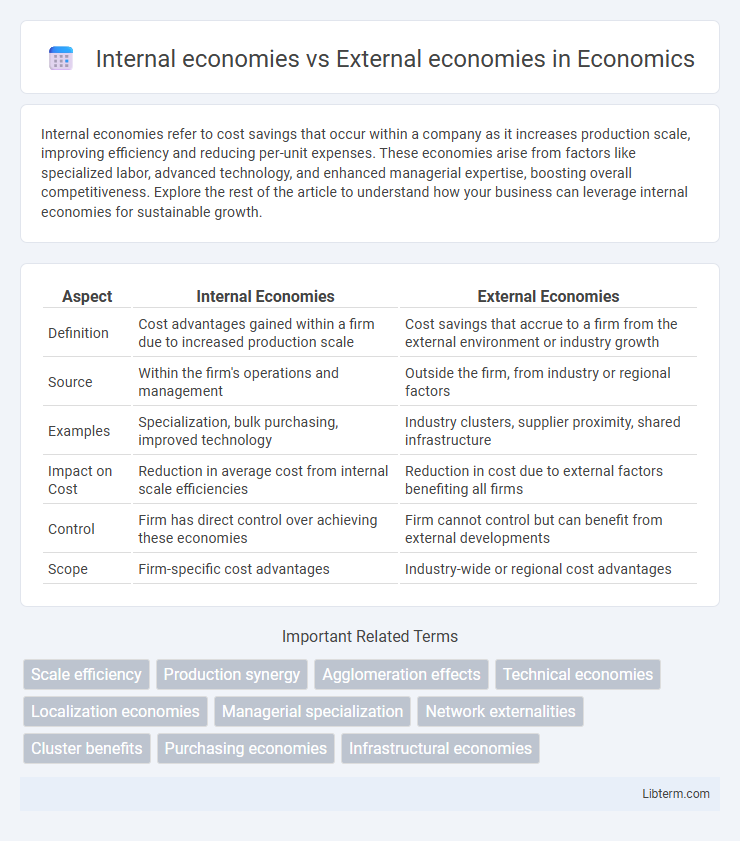Internal economies refer to cost savings that occur within a company as it increases production scale, improving efficiency and reducing per-unit expenses. These economies arise from factors like specialized labor, advanced technology, and enhanced managerial expertise, boosting overall competitiveness. Explore the rest of the article to understand how your business can leverage internal economies for sustainable growth.
Table of Comparison
| Aspect | Internal Economies | External Economies |
|---|---|---|
| Definition | Cost advantages gained within a firm due to increased production scale | Cost savings that accrue to a firm from the external environment or industry growth |
| Source | Within the firm's operations and management | Outside the firm, from industry or regional factors |
| Examples | Specialization, bulk purchasing, improved technology | Industry clusters, supplier proximity, shared infrastructure |
| Impact on Cost | Reduction in average cost from internal scale efficiencies | Reduction in cost due to external factors benefiting all firms |
| Control | Firm has direct control over achieving these economies | Firm cannot control but can benefit from external developments |
| Scope | Firm-specific cost advantages | Industry-wide or regional cost advantages |
Introduction to Internal and External Economies
Internal economies of scale occur when a firm reduces its average costs through expansion and improved operational efficiency within the organization, such as better technology, skilled labor, or bulk purchasing. External economies of scale arise from factors outside an individual firm but within an industry, including improved infrastructure, industry-specific knowledge, and supplier specialization in a geographic area. Both internal and external economies contribute to cost advantages that enhance competitiveness and facilitate growth in production capacity.
Definition of Internal Economies
Internal economies refer to cost advantages that a firm gains as it expands its production scale, resulting from factors within the company such as improved labor specialization, better management efficiency, advanced technology adoption, and bulk purchasing of inputs. These internal factors reduce average costs per unit, enhancing the firm's competitive edge and profitability. Unlike external economies, which arise from industry-wide developments, internal economies stem directly from the firm's own operational growth.
Definition of External Economies
External economies refer to cost savings and productivity gains that benefit a firm due to factors outside its control, typically arising from the growth and development of the entire industry or region. These advantages include improved infrastructure, skilled labor pools, and technological advancements that reduce production costs without the firm incurring additional expenses. External economies enhance competitiveness by providing a favorable business environment shared among multiple firms within the same sector or geographic location.
Key Differences Between Internal and External Economies
Internal economies arise from within a firm, including factors like improved labor efficiency, better management, and advanced technology adoption, directly reducing production costs. External economies originate outside the firm, such as industry-wide infrastructure improvements, supplier specialization, or a skilled local workforce, benefiting all firms in the sector. Key differences include the source of cost savings--internal from the company's own operations versus external from the broader economic environment--and the scope of impact, with internal economies affecting individual firms and external economies influencing entire industries or regions.
Types of Internal Economies of Scale
Internal economies of scale arise from within a company and include technical, managerial, financial, marketing, and purchasing economies. Technical economies stem from improved production techniques and specialized machinery that reduce costs per unit. Managerial economies occur through the division of labor and specialized management, while financial economies benefit from lower interest rates due to better creditworthiness.
Types of External Economies of Scale
External economies of scale arise when cost advantages benefit an entire industry due to external factors such as infrastructure improvements, skilled labor pools, and supplier specialization. Key types include localization economies, which occur when firms in the same industry cluster geographically, facilitating knowledge spillovers and shared supplier networks. Urbanization economies result from the growth of a diverse industry base within a city, enhancing service availability and innovation through varied economic activities.
Importance of Internal Economies in Business Growth
Internal economies play a crucial role in business growth by reducing production costs through increased efficiency, specialization, and technological advancements within the company. These economies enable firms to enhance their competitive advantage by improving resource allocation, optimizing supply chains, and fostering innovation. As a result, businesses experience higher profit margins and scalability, essential for sustainable expansion in dynamic markets.
Role of External Economies in Industry Development
External economies significantly enhance industry development by reducing production costs and fostering innovation through shared infrastructure, skilled labor pools, and knowledge spillovers. Clusters of firms in localized areas benefit from improved supplier networks and collaborative environments, boosting overall industry competitiveness. Government policies and investments in public goods further amplify these external economies by creating supportive ecosystems that attract investment and facilitate sustainable industry growth.
Real-World Examples of Internal and External Economies
Internal economies of scale occur within a firm, exemplified by a car manufacturer reducing per-unit costs through bulk purchasing of materials and advanced robotics automation. External economies arise from industry-wide benefits, such as the Silicon Valley tech cluster where companies gain access to a skilled labor pool and shared infrastructure, enhancing innovation and reducing operational costs. Another example includes the textile industry in Bangladesh, where firms benefit externally from proximity to raw material suppliers and government-supported export facilities.
Conclusion: Comparing Internal and External Economies
Internal economies arise from factors within a firm, such as improved production techniques and better management, leading to cost reductions as output increases. External economies result from industry-wide developments like improved infrastructure or supplier networks that benefit all firms in a sector. Comparing these, internal economies offer competitive advantages specific to a firm, while external economies create shared benefits that enhance overall industry efficiency.
Internal economies Infographic

 libterm.com
libterm.com